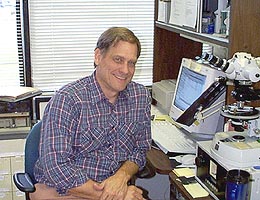 Curator's Comments
Curator's CommentsI continue to be amazed at the number of people that I tell that we are still working on the Moon and they are surprised. Some of these people work at NASA or are reporters that routinely cover NASA (no names). I, of course, try to get the message out, but we all could work at doing this.
The scientific community has suffered a great loss in the passing of our colleague Dr. Graham Ryder. The CAPTEM committee and I will miss his extensive knowledge of the lunar collection. More than once he has been instrumental in determining the right samples for a particular study that has been proposed by a less collection-savvy scientist. See the memorial to Graham in this issue.
All of us at the Curatorial Facility are deeply saddened by the events of September 11, 2001. We are fortunate that our operations were not directly impacted, although there have been and will continue to be delays in daily operations. We have not sent out samples from the last round of allocations in October of 2001. All the allocations are completed, but distribution is awaiting approval of the CAPTEM-recommended allocation plan by NASA Headquarters. This process has been slowed by the added security for mail to Washington DC. We anticipate receiving approval shortly after LPSC. The next round of sample requests, which were due February 15, will be reviewed by CAPTEM immediately following the closing of LPSC 33.
I said this last time, but now I mean it. Our reorganization has been completed and our mail code is now ST. See the article by Carlton Allen in this issue about the Astromaterials Acquisition and Curation at JSC.
Requests for lunar samples for scientific study remain strong. We will send out 105 samples from the last round of allocations approved in October of 2001. Note that the next sample request deadline will be September 15 for the CAPTEM meeting in the fall of 2002. There continue to be requests for long-term display samples. Two displays were approved at the last meeting, which utilize our new case design, and will be exhibited at the American Museum of Natural History in New York and at the Indiana State Museum and Historic Sites in Indianapolis.